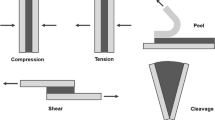Abstract
Cracks in polymers can be healed by endowing materials with self-healing performance. Cracks in epoxy resins containing thermo-reversible Diels–Alder bonds (EP-DA) can be self-healed via different heat treatments. However, EP-DA exhibits the disadvantages of brittleness and poor impact resistance yet as that existed in the common epoxy resins, and which limits the application of thermo-reversible self-healing epoxy resins. Herein, thermoplastic polyurethane (TPU) was introduced into EP-DA for the purpose of reducing the brittleness and improving the impact resistance of EP-DA. Meanwhile, it was expected that the self-healing performance of EP-DA could not be affected evidently. Results showed that the impact resistance of EP-DA had been improved greatly as expected upon TPU modification. More importantly, instead of affecting the self-healing performance of EP-DA, the self-healing speed of EP-DA was accelerated evidently by the incorporation of TPU. On the other hand, the healing efficiency of EP-DA was also enhanced markedly. In fact, TPU-modified EP-DA was repaired by dual actions of thermo-reversible DA reaction and thermal movement of thermoplastic polymer chains. In addition, TPU-modified EP-DA could also be healed for many damage-repair cycles. Therefore, thermoplastic polyurethane played a triple role as toughening, accelerating and enhancing self-healing performance of thermo-reversible epoxy resins.
Graphic Abstract
Thermoplastic polyurethane (TPU) was introduced into thermo-reversible self-healing epoxy resins (EP-DA) successfully. As a result, the brittleness was reduced and the impact resistance of EP-DA was improved greatly. What’s more, instead of affecting the self-healing performance of EP-DA, the self-healing speed of EP-DA was accelerated evidently while the self-healing efficiency of EP-DA was enhanced markedly. Therefore, TPU played a triple role as toughening, accelerating and enhancing self-healing performance of thermo-reversible epoxy resins.








Similar content being viewed by others
References
Russell BK, Takeda S, Ward C et al (2019) React Funct Polym 144:104353
Kocaman S, Ahmetli G (2020) J Polym Environ 28:1190
Sarkar S, Kim B (2016) Polym Compos 39:636
Feng LB, Yu ZY, Bian YH et al (2017) Polymer 124:48
He ZL, Jiang S, An N (2019) J Mater Sci 54:8262
Feng LB, Bian YH, Chai CS et al (2020) J Polym Environ 28:647
Yang SW, Du XS, Du ZL et al (2020) Polymer 190:122219
An SY, Noh SM, Nam JH et al (2015) Macromol Rapid Commun 36:1255
Davis DA, Hamilton A, Yang JL et al (2009) Nature 459:68
Garcia-Jimeno S, Cano-Sarabia M, Mejias N et al (2015) J Mater Chem A 3:17966
Chen QM, Yu XW, Pei ZQ et al (2017) Chem Sci 8:724
Lu YX, Guan Z (2012) J Am Chem Soc 134:14226
Kim S, Jeon H, Shin S et al (2018) Adv Mater 30:1705145
Montarnal D, Tournilhac F, Hidalgo M et al (2009) J Am Chem Soc 131:7966
Thakur VK, Kessler MR et al (2015) Polymer 69:369
Shi Y, Wang M, Ma C et al (2015) Nano Lett 15:6276
Jo YY, Lee AS, Baek KY et al (2016) Polymer 108:58
Feng LB, Yu ZY, Bian YH et al (2018) Constr Build Mater 186:1212
Postiglione G, Turri S, Levi M (2015) Prog Org Coat 78:526
Duval A, Couture G, Caillol S et al (2017) ACS Sustain Chem Eng 5:1199
Henderson JR, Chesterman JP, Parvez M et al (2010) J Org Chem 75:988
Samaneh S, Morteza A, Bahram R (2019) J Ind Eng Chem 75:271
Ma SQ, Liu WQ, Hu CH (2010) Macromol Res 18:392
He S, Shi K, Bai J et al (2001) Polymer 42:9641
Bakar M, Duk R, Przybylek M et al (2009) J Reinf Plast Compos 28:2107
Gui D, Xue G, Hao J et al (2014) Polym Eng Sci 54:1704
Chen TH, Li HS, Gao Y et al (1998) J Appl Polym Sci 69:887
Bakar M, Kostrzewa M, Pawelec Z (2014) J Thermoplast Compos 27:620
Zhao HW, Feng LB, Shi XT et al (2018) Acta Polym Sin 3:395
Chen SB, Wang QH, Wang TM (2013) J Reinf Plast Compos 32:1136
Ho T, Wang C (2015) J Appl Polym Sci 74:1905
Scheltjens G, Diaz MM, Brancart J et al (2013) React Funct Polym 73:413
Grenier-Loustalot MJ, Cunha JD (1998) Eur Polym J 34(1998):95
Acknowledgements
This research is supported by National Natural Science Foundation of China (Grant No. 51463010).
Author information
Authors and Affiliations
Corresponding author
Ethics declarations
Conflict of interest
The authors claim there are no conflicts of interest.
Additional information
Publisher's Note
Springer Nature remains neutral with regard to jurisdictional claims in published maps and institutional affiliations.
Rights and permissions
About this article
Cite this article
Feng, L., He, X., Zhang, Y. et al. Triple Roles of Thermoplastic Polyurethane in Toughening, Accelerating and Enhancing Self-healing Performance of Thermo-reversible Epoxy Resins. J Polym Environ 29, 829–836 (2021). https://doi.org/10.1007/s10924-020-01923-4
Accepted:
Published:
Issue Date:
DOI: https://doi.org/10.1007/s10924-020-01923-4




